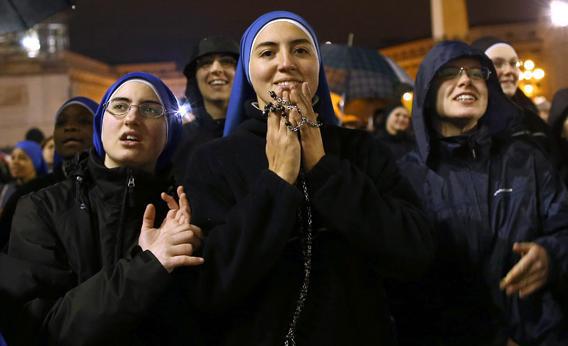Vice President Biden attended the installation of Pope Francis at the Vatican on Tuesday, representing the tens of millions of Catholics living in the United States. Precise estimates of American Catholics vary from 57 million to 78 million. How do you count Catholics?
Surveys, sacraments, or church records. The total number of American Catholics depends largely on what you think it takes to be a Catholic, with the numbers dropping as the required level of commitment increases. It takes very little effort to self-identify as a Catholic, so the Pew Research Center’s survey sets the Catholic population high at 75 million. The Catholic Research Forum has more rigorous standards, defining Catholics as people who are baptized into the church and arrange for a Catholic funeral. By this measure, there are approximately 68 million American Catholics. Finally, some demographers count only people who register at a church or regularly attend Mass. The U.S. Religion Census: Religious Congregations & Membership Study, which asked local church leaders to estimate the number of people in their congregations, set the American Catholic population at just 59 million. Weak church attendance accounts for this discrepancy: Only 24 percent of self-reported American Catholics attend Mass weekly. (Another church-generated estimate, the Official Catholic Directory, estimates the national flock at 66.3 million, but critics worry that clerics inflate the numbers for this publication for PR reasons.) What do these numbers mean? There’s a population of approximately 19 million Americans who think they’re Catholic but who are unknown to their local priests.
None of these methods accurately captures the Vatican’s view of the Catholic population. Under church law, baptism makes you a Catholic, and you remain a Catholic until you’re excommunicated or formally repudiate the faith. Since more people unilaterally abandon Catholicism than join it without baptism, the Vatican’s census is typically even higher than the number of self-identified faithful. The official Statistical Yearbook of the Church counts a total of 1.196 billion Catholics worldwide, or 96 million more than Pew does, a difference of about 9 percent. Variances within individual countries can be far more extreme. The Vatican’s estimate for Brazil is 29 percent higher than Pew’s.
Estimating the size of other Christian groups isn’t quite as challenging because self-identification is all that matters for many of them. In the United States, most demographers accept census data in estimating the size of the Lutheran or Presbyterian population, for example (8.6 million and 4.7 million, respectively, according numbers from 2008). In certain countries, census figures are either unreliable or nonexistent, forcing researchers to rely on health surveys and other interview methods.
Catholics aren’t the only religious group that presents a challenge to demographers. While calculating the worldwide Muslim population is fairly straightforward, breaking that number into Sunni and Shiite populations is not. Few surveys make that distinction, and many Muslims refuse to self-identify in one of those groups. As a result, in their 2010 report “Mapping the Global Muslim Population,” Pew relied on local ethnographers to estimate the approximate breakdown of Sunni and Shiite in each country’s population. The method was so improvisational—at least by Pew’s standards—that they were unable to provide a margin of error.
Got a question about today’s news? Ask the Explainer.
